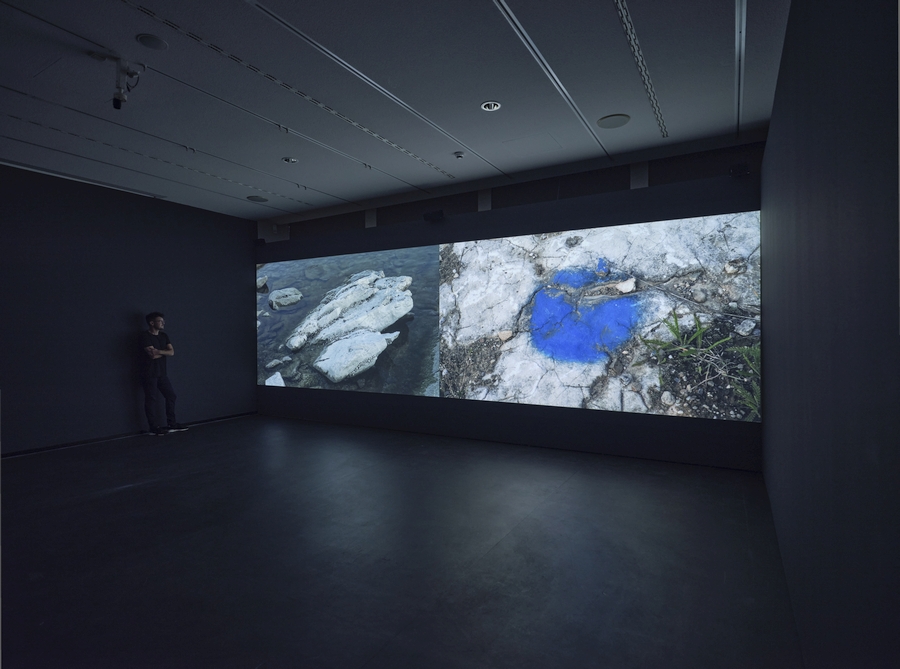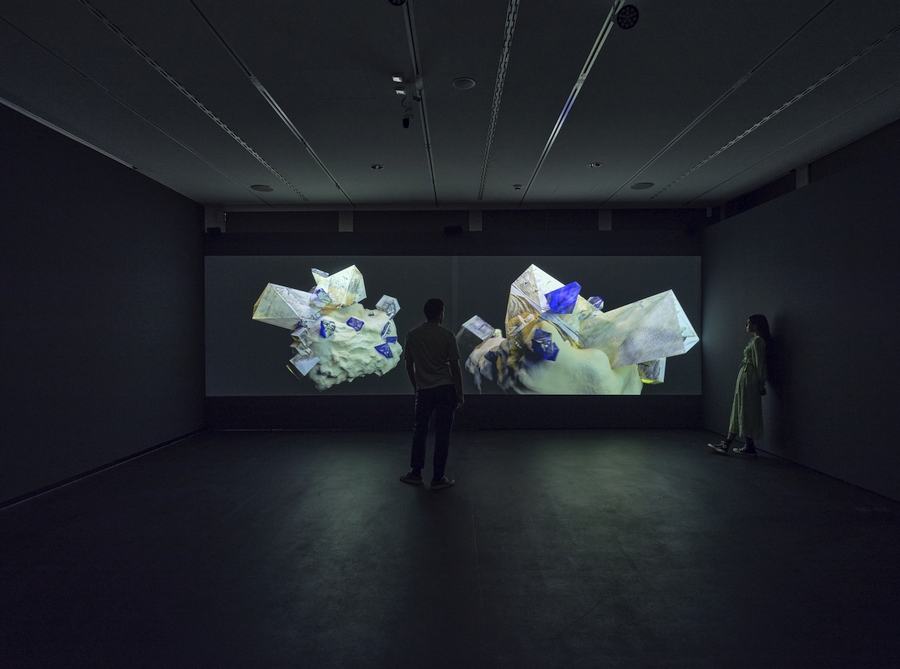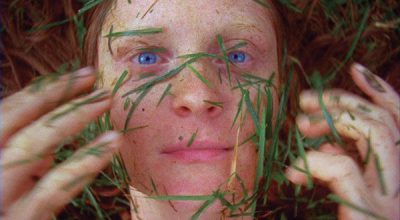
IGNACIO ACOSTA’S ARCHAEOLOGY OF SACRIFICE
“The rocks are bones. In them are the traces of a very modern crime,” narrates the installation’s voiceover. The disembodied voice speaks to the state of Mormont Hill –a limestone and marl quarry located in the Swiss canton of Vaud which, in 2006, was found to have once been a Celtic sacrificial site. Centering on this discovery, Ignacio Acosta’s two-channel video installation with surround sound design, Archaeology of Sacrifice (2020), unveils how the notion of sacrifice has transitioned from ancient sacred rituals to its contemporary meaning within extractive capitalism.
Evidence suggests the Celts living at Mormont Hill during the second century BCE were experiencing a moment of crisis, perhaps linked to Germanic invasion. Thus, they buried offerings in the form of several human and animal bodies, tools and bronze vessels to the Earth in exchange for guidance through the catastrophe. Today, sacrifice is mediated by market exchange –the well-being of humans, non-humans and the environment has been betrayed in favour of economic growth. Sacrifice zones are proliferating in areas deemed most extractable, most exploitable –usually regions under pressure from neoliberal policies. Here, humanity and nature are believed to be expendable and replaceable. Whilst acknowledging the Anthropocene is built on an erasure of its racial origins and climate change has been whitewashed, Archeology of Sacrifice reflects on the precariousness of our planet and its unsolicited submission to humanity.

As Ina Neddermeyer, curator and head of the art department at the Zeppelin Museum Friedrichshafen describes, Acosta’s “reflections on the extremely multi-layered web of archaeological and political dimensions that define this area are based on intensive scientific research. As a scientist and artist in one, he adopts forensic practices.”[1] She continues: “Acosta’s forensics are always political, in keeping with the Latin meaning of the term forensic, which can be translated as ‘of the forum or the marketplace’. In Ancient Rome, litigations, examinations, pronouncements of judgements as well as the implementation of punishments were carried out publicly and mostly on the marketplace or forum.”[2]
In tracing and uncovering the sacrificial shift, the installation distances the notion of sacrifice from its former connection to the sacred, the divine, and the establishment of bonds of love and solidarity once known to the Celts. Archeology of Sacrifice’s extracted minerals and limestone “have now become fetish objects. They revolve around their own axis not only in the video, but also figuratively. They are the objects of a new cult: raw materials that represent further intrusions into nature and extensive building projects.”[3]
Currently, the mining industry is seeing a growing trend in combining different types of automated technologies –from and beyond robotics, artificial intelligence, augmented reality and drones– thereby transforming the efficiency of the industry. In keeping with his perpetual desire to “expose and publicize highly ambivalent power dynamics,”[4] Acosta’s installation subverts the profitable use of drone technologies to highlight the negative footprint of industrial extractive activity on the valuable natural environment of Mormont Hill. “The combination of different kinds of footage in the installation is intentional: archival material, Acosta’s own shots, some of them taken with a drone, and 3D renderings merge in a distinctive narrative structure. The slow tracking shots decelerate the narrative pace: long shots provide a detailed view of the natural surroundings and its components. Nature thus becomes an individual protagonist.»[5]



Mormont Hill’s excavated objects help archaeologists fiction a past, though almost certainly, the Celts did not intend for these remains to be uncovered. This message is, “especially poignant in these visual juxtapositions: the violent laboring of the excavator and the careful, delicate exposure of the cult site, actions that seem contrary at first sight, but are much the same in the finality of their extraction.”[6] In archaeology, formulating past beliefs involves a delicate navigation between fiction and reality in which the lines are always blurred; the reconstruction will always be a representation. Archeology of Sacrifice builds on this grey area in our own moment of current crisis, pushing for a more earthly understanding of prospective cohabitation whilst offering a reflective space for an unknown future. As Neddermeyer elaborates, “The interconnection of real and fictional elements is a key factor in the video, as manifested in the juxtaposition of real and fictional minerals.
Likewise, the visual and linguistic translating processes underline the different narrative levels. While the original text was written in Spanish by Carlos Fonseca, the voiceover speaks Swiss French. The subtitles, on the other hand, appear in English and German. The visual translating process –the minerals were derived from the historical publication Minéraux[7] and then translated into renderings– underscores the reciprocal pervasion of fiction and reality.”[8] The installation’s continuous interplay between fact, fiction and scale echoes Acosta’s artistic strategy of juxtaposing which, as Neddermeyer points out, is also reflected in the work’s form: “He uses two-channel installations to draw connections, illustrate dichotomies and contrasts, and to reveal associations. This enables the visual articulation of multiple possibilities of similarity and difference, and proximity and distance.»[9]
In line with Frederic Jameson’s musings on the relationship between utopia and science fiction, and seeing the latter’s strength in failing to accurately imagine a real future, Archeology of Sacrifice similarlyplays with our imagination’s incapacity. Global capitalism is once again responsible; we’re frozen within its trap, unable to seek alternatives. Instead of presenting a conclusive vision, the film offers a plethora of prospects which “defamiliarize and restructure our experience of our own present.”[10] Similarly ambiguous are the owners of the land –“Is it the past that imbues it with cultic significance, the present that promotes the limestone as a new fetish object, or the future with its next human and nonhuman creatures as the owners for whom nature must be preserved?”[11]. With these questions, the installation views the imaginary as a process of becoming, one whose function is “transforming our own present into the determinate past of something yet to come.”[12] Akin to reconstructing the past, imagining the future is consistently a representation.


Archaeology of Sacrifice was created in collaboration with film editor Lara Garcia Reyne, artists Valle Medina and Benjamin Reynolds (Pa.LaC.E), writer Carlos Fonseca, sound designer and composer Udit Duseja, and colorist Paul Wills. The film includes archival footage from the documentary Crépuscule des Celtes (2007) by Stéphane Goël, Climage. It was produced as result of the Scholarship 2020 of the ZF Kunststiftung, Friedrichshafen, Germany, filmed during Principal Residency Program, La Becque Résidence d’artistes, La-Tour-de-Peilz, Switzerland, and with the collaboration of the Musée cantonal d’archéologie et d’histoire/Lausanne, Switzerland.
It is presented first by ZF Art Foundation at the Zeppelin Museum Friedrichshafen and curated by Regina Michel.
18.9–6.12.2020.
[1] Neddermeyer, I “The Beauty of Forensics. Ignacio Acosta’s Archaeology of Sacrifice” in Archaeology of Sacrifice, ZF Art Foundation Guest catalogue. Kunststiftung der ZF Friedrichshafen, AG and modo Verlag, Freiburg, Germany, 2020 (forthcoming).
[2] Idem.
[3] Idem.
[4] Idem.
[5] Idem.
[6] Idem.
[7] Claus Caspari, Helmut Schröcke, Karl Ludwig Weiner, Jean Wyart: Minéraux: 162 planches en 7-9 couleurs d’après les originaux de C. Caspari, Collection de documents d’histoire naturelle, Kronen-Verlag Erich Cramer, Hamburg – éditions S.F.L SFL Société Française du Livre, Paris, Printed in Germany, 1971
[8] Neddermeyer, I, 2020
[9] Idem,
[10] Jameson, F. Archaeologies of the future: the desire called utopia and other science fictions. Verso, London, 2005, p 738
[11] Neddermeyer, I, 2020
[12] Jameson, F (2005) pp 738–741
También te puede interesar
CRISTINA FLORES PESCORÁN: LAS PREDICCIONES
La muestra reúne un conjunto de piezas producidas entre 2020 y 2022 que subrayan un aspecto clave de su trabajo: repensar la relación entre salud y enfermedad. El punto de partida es personal. Una...
“TIERRA” DE REGINA JOSÉ GALINDO, RELEVANTE UNA VEZ MÁS
La presentación de la obra de Galindo es la primera de una serie de colaboraciones entre el MoMA y el MoMA PS1 para destacar obras de la colección del Museo de Arte Moderno. “Creo...



